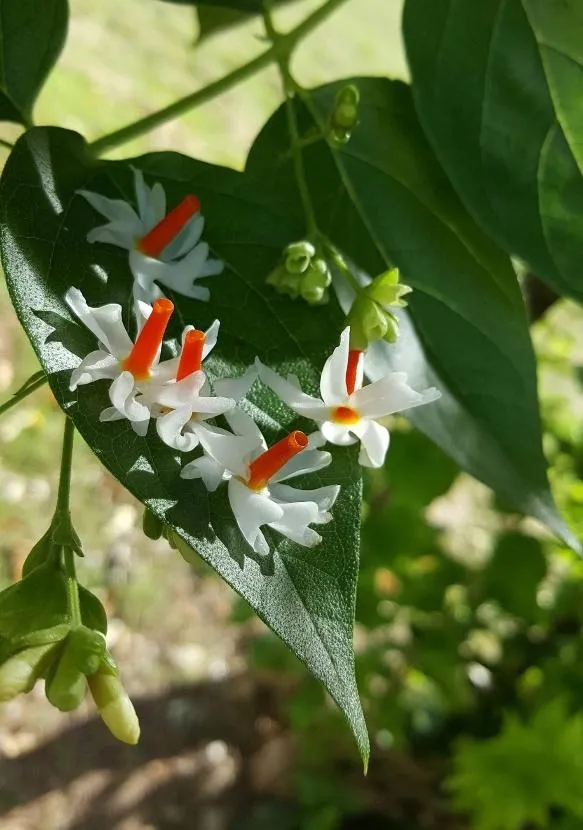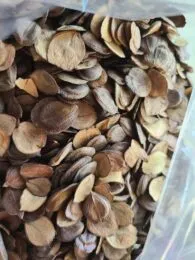The Enchanting Parijata Flower: A Comprehensive Guide
What is the Parijat Plant?
Parijat (Nyctanthes Arbor-Tristis), also known as the Night-Flowering Jasmine or Coral Jasmine, is a captivating species indigenous to South and Southeast Asia. Despite its common name, Parijat is not a true jasmine and belongs to the Oleaceae family. This plant thrives in the outer Himalayas and is found in regions like Jammu & Kashmir, Nepal, Assam, Bengal, and Tripura, extending to the Godavari in the South. Besides India, Parijat is also found in Thailand, Indonesia, Nepal, and Pakistan.
The Parijat flower is often referred to as the “tree of sorrow” because its flowers lose their vibrancy during the day. In India, it is also known as “Harsingar” or “The Gods’ Ornament,” making it the only flower that can be picked up off the ground and offered to the Gods. It is believed to help in recalling memories of previous lives and incarnations.
Parijat: Key Facts
| Botanical Name | Nyctanthes arbor-tristis |
|---|---|
| Family | Oleaceae |
| Common Names | Night-flowering jasmine, parijat, hengra bubar, harsingar |
| Native | South and Southeast Asia |
| Sunlight | 5 to 6 hours of direct sunlight |
| Soil | Damp, permeable soil that drains well |
| Watering | Moderate |
| Fertilizer | Organic fertilizer |
| Maintenance | Low |
Parijat: Description
The Parijat is an ornamental shrub that can grow up to 13 feet tall. Its leaves are alternate, simple, and have an entire border, measuring 6-12 cm long by 2-6.5 cm wide. The night-blooming jasmine produces petite, fragrant, tubular blooms that open at night and have five to eight lobes with an orange-red center. These flowers develop in groups of two to seven and are incredibly fragrant, filling the air with a sweet floral scent at night. The plant also bears tiny white berries, which birds consume and disseminate. The flowers bloom from August to December.

Source: Pinterest
How to Grow Parijat Plant?
Growing Parijat from Cuttings
- Take a cutting 6 to 8 inches long from a healthy plant in the spring or early summer.
- Remove all leaves from the lower area, leaving a few at the top.
- Plant the cutting in a pot with well-draining potting soil.
- Water it well and cover it with a plastic bag.
- Place the pot in an area with bright, filtered sunlight.
- Moisten the soil frequently if it feels dry.
- New roots will grow within 3–4 weeks.
Growing Parijat from Seeds

Source: Pinterest
- Collect fresh seeds from the Parijat plant.
- Soak the seeds in warm water for 24 hours.
- Fill a seed tray or small pots with well-draining soil.
- Place the seeds on top of the soil and lightly cover them.
- Water the soil gently to keep it moist.
- Place the tray or pots in a warm, bright location away from direct sunlight.
- Keep the soil consistently moist.
- Once the seeds sprout, thin them out and transplant them to larger pots or directly into the ground.
Growing Parijat from Cuttings (Alternative Method)
- Take a healthy cutting from a young stem with softwood.
- Remove the leaves from the lower half and dip the cut end in rooting hormone or water.
- Plant the cutting in well-draining soil and keep it moist.
- Cover the pot with a plastic bag or glass jar to maintain humidity.
- Place the pot in a bright, warm location away from direct sunlight.
- After a few weeks, roots will form, and the plant will begin to grow.
- Once established, remove the covering and continue to care for the plant.
How to Use Parijat Leaves?
Parijat leaves can be used in various ways, such as:
- Making tea
- Extracting essential oils
- Preparing poultices or pastes for medicinal purposes
What is Parijat Flower Called in English?
The Parijat flower is also known as Night-flowering Jasmine or Coral Jasmine in English.
Parijat: How to Maintain?
Sunlight
The Parijat plant adores the sun. After it has grown, keep it in a spot that receives 5 to 6 hours of direct sunlight. Avoid shaded areas as they result in restricted growth and fewer flowers.
Soil
Use healthy, damp, permeable soil that drains well. Add organic material like aged cow dung manure, compost, or vermiculture. For containers, any common potting soil will do, or you can make your own mix by combining equal parts of coarse sand, garden soil, and cow dung manure.
Watering
Keep the soil wet but not soggy. Only water when the topsoil is no longer moist. Check the moisture level by poking the soil with your finger or a stick. Water the plant extensively in the summer and sparingly in the winter and rainy seasons.
Fertilizer
Loosen the topsoil before applying fertilizer to help the plant absorb nutrients and moisture. Feed the plant with organic fertilizer once a month during the primary growing season. Water immediately after applying fertilizer.
Protection
Remove any damaged, diseased, or dead plant parts and dispose of them far from living plants. Use Neem oil, Eucalyptus oil, or citrus oil spray as an initial treatment for any disease or insect attack.
Don’ts
- Avoid over-watering, especially if the pot lacks drainage holes.
- Avoid drenching flowers and leaves to prevent fungal infections.
- Standing water can kill and rot the roots.
- Annual fertilization is beneficial.
- Prune the plant due to uneven growth.
- Place the plant in a shaded area that gets a few hours of direct sunlight.

Source: Pinterest
Parijat: Uses
- Health Benefits: Controls excessive blood sugar levels, treats sciatica, arthritis, fevers, and acts as a laxative.
- Medicinal Properties: Effective in treating malaria symptoms, sedative, antioxidant, anti-inflammatory, and diuretic properties.
- Other Uses: Cures dry cough, strengthens immunity, controls anxiety, relieves menstrual cramps, avoids dental problems, treats gastrointestinal issues, and helps in getting rid of worm infestation.
- Cosmetic Uses: Used in face packs for a garish shine and to cure skin conditions.
- Hair Care: Strengthens hair, prevents hair loss, and treats scalp conditions.
- Culinary Uses: Used in Assamese culinary recipes.
- Fragrance: Flower oil is used as a fragrance and in incense sticks.
Parijat: Toxicity
Although this fragrant plant attracts butterflies and birds, it is toxic to mammals, including dogs and humans. Prevent your dog from sniffing the plants too much or eating them. Some mammals may experience mildly harmful side effects from inhaling the plant’s scent, including nausea, vertigo, and throat and nose irritation.
Conclusion
The Parijata flower is not just a beautiful addition to your garden but also a plant with numerous health benefits and uses. Whether you grow it from seeds or cuttings, the Parijat plant is relatively easy to maintain and offers a delightful fragrance that can fill your garden with its enchanting aroma. However, be cautious of its toxicity to mammals and ensure it is placed in a suitable location to thrive.
